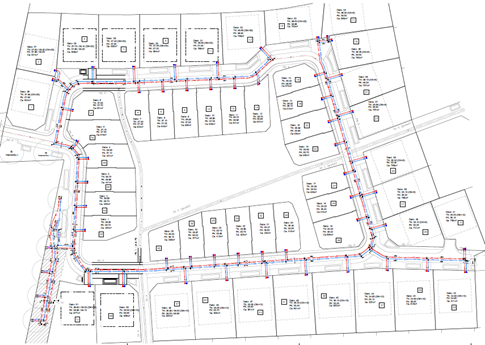Rendebjergvænget - thermonet in Tune, DK
5G network

Picture credits: Damgaard Rådgivende Ingeniører
Facts at one glance
Status of the project:
Commercially operating
Operation mode:
Heating network
Geothermal source:
Shallow / Ambient Geothermal
Max heat capacity:
< 1MW
Network generation:
5G
Year of operation start:
2021
Contact:
kontakt@termonet.dk
Description of the project
The thermonet in Tune supplies 51 households, and consists of 3.600 horizontal PE-pipes of 40-125 mm, as well as 6 vertical geothermal boreholes of 200 meters in depth. The thermonet is closed circuit and designed with a distance to other installements in the ground to prevent freezing of the waterpipes. The brine is a mixture of 70% water and 30% IPA.
Each household owns and has the responsibility of their own heatpump, however there is a collective circulation pump in a common station. The heatpumps are Nilan Compact P GEO Type "3" or "6", with the performance of 3 kWh and 6 kWh respectively.
The individual heatpumps deliver the heating of the interior, and no cooling is available as there is no heat storage. Warm water is supplied through a seperate heatpump, running on energy from the ventilated air. As safety devices, expansionvessels and safety valves are placed in each of the individuel heatpumps.
Highlights of the project
- Thermonet can be a suitable solution as an alternative to district heating or individual air source heat pumps. Especially in areas such as this, where district heating was not possible and individual air source heat pumps was not as attractive a solution due to the problems of space and noise. With thermonet the individual heat pumps takes up less space, and does not emit any outside noise.
- The pumps in the heat pumps has been replaced with regulationvalves, for the central pump to drive the brine on its own. This solution can result in lower investment costs for the heat pumps, as well as lower operational costs.
The biggest challenges / obstacles
- Fewer and bigger heat pumps could potentially reduce the overall costs of investment and maintenance, for instance by having two households sharing one heat pump. This would however result in greater requirements to the design of the thermonet.
- Future projects could consider including cooling of the households, for greater comfort and a small additional cost. I terms of energy, cooling can involve storage of some amount of heat, which can be of later use in the winter. Apart from being an advantage to the design and lifetime of the thermonet, it will also provide operational savings.
- It is expected that a common service agreement for the heat pumps would be an operational economic improvement, instead of individual costs of service.
Detailed characteristic of the project
Site description
Address
Rendebjergvænget, 4030 Tune, Denmark
Status of the project
Commercially operating
Year of operation start
2021
Type of geothermal Heating / Cooling network
Heating network
Type of geothermal technologies involved
Shallow / Ambient Geothermal
Are heat pumps used within this project?
yes - located at the clients
Heating network generation
5G
Number of clients supplied
10 - 100
Depth range
1-200
Involved companies
Owner / operator
Lind & Risør
Planner / installer
Damgaard Rådgivende Ingeniører
Driller
GeoDrilling
Types of used geothermal sources
Source
Depth range
Temperature range
Purpose
Soil/rock - closed loop
< 20 meters
< 20°C
Heat extraction
Soil/rock - closed loop
20 - 400 meters
< 20°C
Heat extraction
System design
Heat sources included in the network
Monovalent - geothermal energy is the only heat source
Max heating capacity supplied by geothermal energy
< 1MW
Share of geothermal energy
70% - 80%
Annual operation hours for heating
2000 hours - 4000 hours
Annual heating production
< 1 GWh
Annual heating production share
70% - 80%
Energy conversion factor linked to the use of geothermal energy
< 5
Heat source for peak load supply
Geothermal
Has backup system?
Yes
Backup system
Electricity
Share of fossil fuels for annual gross heat production
0 %